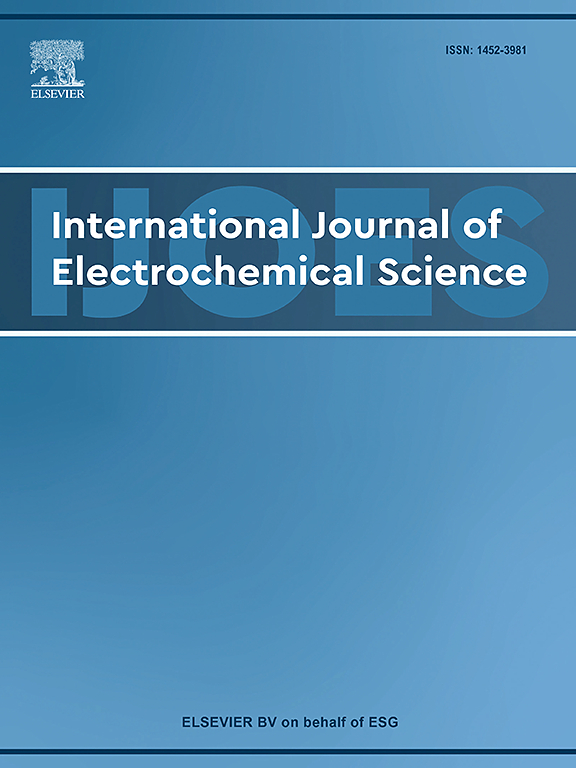Electrochemical technologies for sustainable agricultural water treatment and resource recovery
IF 1.3
4区 化学
Q4 ELECTROCHEMISTRY
International Journal of Electrochemical Science
Pub Date : 2025-04-11
DOI:10.1016/j.ijoes.2025.101029
引用次数: 0
Abstract
Electrochemical technologies are emerging as modular, low-chemical, and energy-efficient solutions for treating and valorizing agricultural water streams. This review synthesizes the state-of-the-art in six core electrochemical processes—electrocoagulation, electroflotation, electrodialysis, capacitive deionization, electrochemical advanced oxidation, and electro-reductive pathways—and evaluates their effectiveness for removing sediments, nutrients, salts, organic micropollutants, and pathogens. We compare removal efficiencies, resource-recovery yields, energy consumption, and operational challenges across bench-, pilot-, and field-scale studies. Key insights include the high phosphorus recovery (>99 %) achievable via electrocoagulation, selective nitrate concentration by electrodialysis for fertilizer reuse, sub-kWh m⁻³ energy footprints of capacitive deionization for brackish irrigation water, and > 99 % degradation of persistent pesticides using advanced oxidation anodes. Looking ahead, we identify three critical research priorities: (1) development of low-cost, fouling-resistant electrode materials tailored for complex agricultural matrices; (2) integration of electrochemical units with renewable energy sources and biological polishing to maximize circularity; and (3) techno-economic assessments and long-term field demonstrations to validate performance under variable on-farm conditions. Addressing these gaps will accelerate deployment of decentralized electrochemical water treatment systems—advancing nutrient circularity, safeguarding water resources, and enhancing resilience of agricultural landscapes.
可持续农业水处理和资源回收的电化学技术
电化学技术作为模块化、低化学和节能的解决方案正在兴起,用于农业水流的处理和增值。本文综述了电絮凝、电浮选、电渗析、电容去离子、电化学高级氧化和电还原等六个核心电化学过程的最新进展,并评估了它们在去除沉积物、营养物、盐类、有机微污染物和病原体方面的有效性。我们比较了台架、试验和现场规模研究的去除效率、资源回收率、能源消耗和操作挑战。主要的见解包括通过电凝实现高磷回收率(> 99% %),通过电渗析实现肥料再利用的选择性硝酸盐浓度,微盐灌溉水电容去离子的能量足迹低于千瓦时m(⁻³ ),以及使用高级氧化阳极对持久性农药的降解>; 99% %。展望未来,我们确定了三个关键的研究重点:(1)开发适合复杂农业基质的低成本,抗污垢电极材料;(2)将电化学单元与可再生能源和生物抛光相结合,实现循环最大化;(3)技术经济评估和长期现场演示,以验证在可变农场条件下的性能。解决这些差距将加速分散式电化学水处理系统的部署,从而促进养分循环,保护水资源,增强农业景观的复原力。
本文章由计算机程序翻译,如有差异,请以英文原文为准。
求助全文
约1分钟内获得全文
求助全文
来源期刊
CiteScore
3.00
自引率
20.00%
发文量
714
审稿时长
2.6 months
期刊介绍:
International Journal of Electrochemical Science is a peer-reviewed, open access journal that publishes original research articles, short communications as well as review articles in all areas of electrochemistry: Scope - Theoretical and Computational Electrochemistry - Processes on Electrodes - Electroanalytical Chemistry and Sensor Science - Corrosion - Electrochemical Energy Conversion and Storage - Electrochemical Engineering - Coatings - Electrochemical Synthesis - Bioelectrochemistry - Molecular Electrochemistry

 求助内容:
求助内容: 应助结果提醒方式:
应助结果提醒方式:


